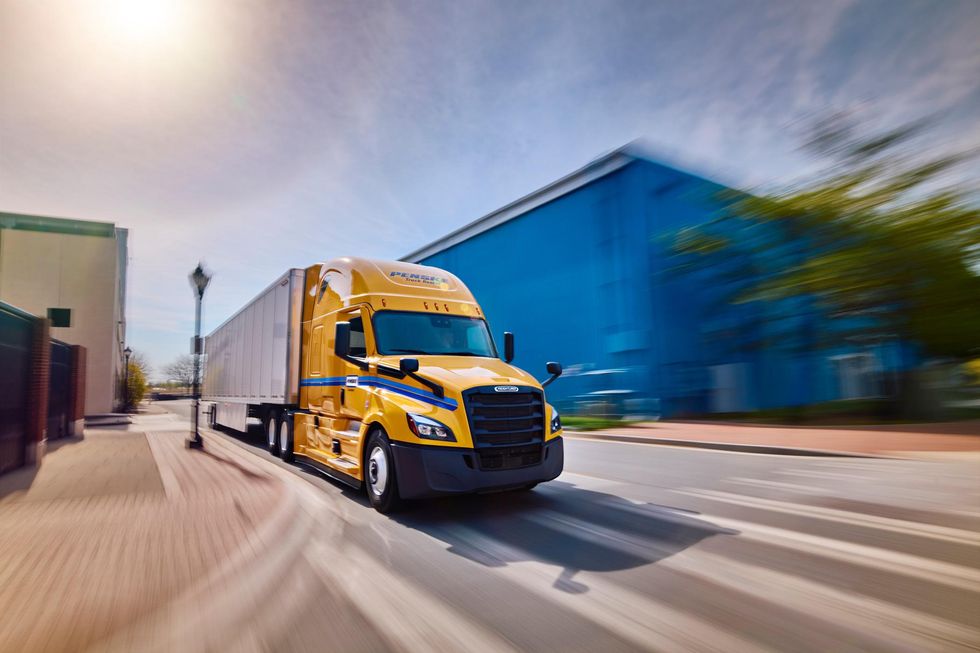
National Private Truck Council (NPTC) Survey Highlights Value, Performance of Private Fleets
The National Private Truck Council 2021 Benchmarking Survey Report provides fleets with new industry standards to evaluate performance and identify opportunities for improvement.
"Information is power," explained Jim Lager, senior vice president for Penske Truck Leasing. "Fleet operators need real-time data to make informed decisions about their business. They want to know if what they are doing is best-in-class or underperforming, and how they can improve. Being able to see that information helps them identify areas of opportunity within their operations."
Lager added that every aspect of the supply chain is stressed right now. "I think it is even more critical to have good information and good partners to talk to about it," he said.
The 2021 NPTC Benchmarking Survey Report, which is sponsored by Penske, captures critical metrics from the 2020 calendar year, which was a time like no other.
"The purpose of this report is not to critique any fleet's performance, but rather to give them the tools so when they need the answers and the metrics in their continuous improvement efforts that they can grab onto those metrics in the report and move on," said Tom Moore, executive vice president of NPTC.
Even with the challenges, private fleets performed well and used their advantages to navigate supply chain challenges, hauling more shipments and volume than they did in the previous year.
Moore continued: "The thing that really impresses me, despite everything that is going on in the pandemic, is the stability that occurred in our private fleet management. We didn't see extreme swings in terms of equipment buying or a lot of change in the driver hours, even though the DOT extended those hours. Those folks stuck right in that core business. I thought that was a telling statement for how private fleets position themselves for success."
Supply chain challenges have helped private fleets raise the awareness and importance of transportation generally within their companies.
"In the last three to four years, companies have decided to start their own private fleet from scratch because of the vulnerability in finding transportation," said Gary Petty, CEO of NPTC. "I think a lot of companies are saying, 'We can manufacture the greatest product around, but if we can't get it in a way that has no damage and no loss that is timely, it doesn't matter.'"
Many private fleets shined during COVID disruptions and were able to navigate capacity constraints and surging costs others faced within the transportation market, strengthening the case for having a private fleet.
"Private fleets are resilient and flexible," Lager said, adding that more and more companies are considering and transitioning to private fleets. "That is a result of the spot market and the carrier situation driving them toward that so they could control their destiny. They don't want to trust that to a carrier. They want to do it with a partner like Penske."
Petty stated 75% of the private fleets in the study are operating as cost centers or, as he calls them, contribution centers. "They're in it to provide outstanding customer cost in the most effective and efficient manner possible. Whatever financial model, the goal is to deliver exceptional levels of customer service in the most efficient manner possible," he said.
As in years past, the primary reason companies report operating a private fleet is to provide exceptional levels of customer service that are unavailable on the open market, especially at a time when transportation and logistics capacity has been relatively constrained.
In the latest study, more than 92% of the respondents, in response to the open-ended question, 'What is the primary reason your company operates a private fleet?,' answered customer service.
Measuring on-time performance remains the primary means of tracking customer service, although other metrics are growing in acceptance.
This year 68% of the fleets report measuring on-time performance as opposed to 82% last year.
This erosion in on-time deliveries makes room for a bevy of other metrics, according to the NPTC report, most notably safety scores, tracked by 56% of respondents (53% last year); cost-per-mile, tracked by 55% of the respondents (35% last year); and customer comment, tracked by 32% of the population.
Shipments for private fleets were up from last year by 9.7%, and volume was up by 5.6%. This growth is supported by an overall mileage increase of 5.7%, which means that fleet respondents accomplished these gains rather efficiently, according to the report.
Even still, private fleets do face challenges, with driver-related issues being the No. 1 challenge listed. Driver-related issues are cited by nearly every respondent, often more than once. Rounding out the list of issues cited by fleets are: Cost-related issues; equipment and maintenance; customer service; regulatory and safety.
While driver issues remain top-of-mind, private fleets perform better than the for-hire population. "While everybody is feeling the driver shortage, it is less at private fleets," Penske's Lager said.
This year's survey found that driver turnover fell to 15.8%, nearly three full percentage points down from last year's 18.5% turnover rate and much lower when compared to the for-hire segment. Private fleet's average driver turnover is 14.25% over the 15-year history of the survey, and the average driver in the NPTC survey stays with a carrier for more than ten years. "That is extraordinary," Petty said.
NPTC started tracking metrics surrounding the time to hire and the hiring process for the first time. NPTC found that the average fleet has to review, screen and/or interview 19.7 candidates to fill one driver's seat, and the average time to hire a driver candidate is 34 days.
"Private fleets understand you get what you pay for," Moore stated. "They changed the mentality from speed-to-hire because they want to hire the right person.
The three top reasons for turnover are discipline issues, drivers leaving for another job, or retirement.
Moore noted: "For those leaving for another job or discipline issues, that tells me a private fleet can do a better job in the hiring process. If you're asking the right questions in the interview, you can identify what drivers are more likely to leave or will have discipline issues."
For the first time, NPTC asked fleets how much it cost to bring a driver on board. It is about $7,500 for the typical heavy-duty operation, and $3,400 for medium-duty fleets.
The survey also examined which freight movements private fleets haul and which they contract out. Private fleets typically handle about 2/3 of the outbound flow of goods and work with third-party carriers to handle the rest.
For-hire motor carriers handle 17% of all outbound freight movements, while dedicated contract carriers perform 12%. When deciding how to position the private fleet, survey respondents mention numerous inter-related and overlapping factors. The most frequently highlighted are cost, service, geography, and proximity to customers, and backhaul loads.
Empty mileage rates decreased, with an empty mileage of 26% down from last year's 33.3% and the previous year's 28.4%. NPTC found that 28% of respondents reported improved empty mileage, and Lager said reducing empty miles is top-of-mind for carriers. "There is not the luxury of being inefficient right now."
Penske Truck Leasing helps customers analyze their network to determine the best lanes to handle internally and the best to outsource.
"We have the engineering capability and capacity to analyze a customer's entire operation and make a recommendation," Lager said. "We can process the data and optimize it in several ways. It isn't always about cost; it is about delivery windows and meeting schedules. We can display all of that and help them make those decisions."
Use of on-board safety technology continues to increase, and not one respondent indicated not using on-board safety technology.
"If you're not safe, you're not going to be efficient, and the rest of the metrics don't matter," Moore said. "The safety record continued to get better and stronger and was one of the best years we ever had."
Survey participants can request customized data pulls that compares data of peer or like-kind fleets in the same market.
Petty: "It is apples-to-apples numbers they can use. This is powerful information internally. We have found once companies get on the track of scoring themselves against peers, it gives the whole benchmarking exercise a powerful boost of credibility."
By "Move Ahead" Staff
